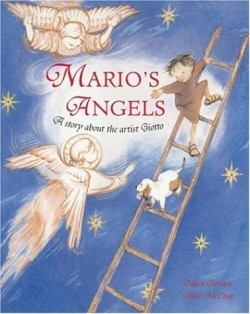Mario's Angels
A Story About the Artist Giotto
When Mister Giotto runs into trouble trying to finish his Nativity fresco in the Scrovegni Chapel, young Mario dreams up a wonderful solution in this holiday-inspired introduction to the work of Italian Renaissance painter Giotto di Bondone.
Known simply as Giotto, this Florentine painter of the late thirteenth century made a major contribution to the art world. At this time, frescos (paintings done on wet plaster) were still largely without three-dimensional perspective, and the personages in them were portrayed in a stiff and formal manner. Giotto departed from this tradition: in his Nativity (a photograph of which follows the fictional text), he painted in a more realistic fashion than his predecessors. Giotto is considered “the father of European painting” because this realistic technique, though not his style as a whole, became the standard for centuries to come.
The author, who studied at the National College of Art and Design in Dublin, Ireland, and at the University of Florence in Italy, taught art for eighteen years before she began writing books for children, including Pa Jinglebob and Lawlor’s Revenge. Her love of art shines through in this tale of a young boy who, with his puppy, hangs around the church. They watch Mister Giotto paint, climb on the scaffold, track paint, and ask questions.
Noticing that the painted people look real, Mario said, ‘I’ve never seen real people in paintings before.’ ‘I like my people to look real and move about,’ said Giotto. ‘I’m real,’ said Mario, ‘and I move about a lot. Can I be in your fresco?’
Young children will appreciate Mario’s disappointment at being told he’ll have to grow up before he can help, and they will be delighted when Mario finds a way to “fix the sky,” as Father Prior requests.
The illustrator’s previous children’s books include Tog the Ribber, which was short-listed for the Smarties Book Award and Highly Commended for the Kate Greenaway Award, and Selkie, which won the Parent’s Guide to Children’s Media Award. Here, she uses a palette of pastel and earthy watercolors that duplicates the effect of Giotto’s Nativity. The layout is a harmonious combination of single, three-quarter, and double page spreads, as well as multiple-frame pages that allow the action to unfurl at a quicker pace. There is enough pictorial detail (housewares, the ever-present puppy) to engage but not overwhelm the young viewer, and the text, which is simple enough for emergent readers, is integrally entwined with the illustrations.
Art teachers looking for art history books to supplement their curriculum and librarians looking for additions to their holiday collections will be pleased with this fine picture book.
Reviewed by
Jeanne M. Lesinski
Disclosure: This article is not an endorsement, but a review. The publisher of this book provided free copies of the book to have their book reviewed by a professional reviewer. No fee was paid by the publisher for this review. Foreword Reviews only recommends books that we love. Foreword Magazine, Inc. is disclosing this in accordance with the Federal Trade Commission’s 16 CFR, Part 255.

